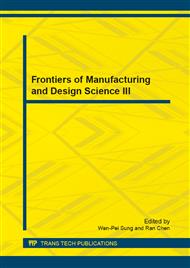[1]
Qilong Shi, Peng Xiao, Feng Zheng, Grinding Effect of C/C-SiC Composites Prepared by Isothermal Chemical Vapour Infiltration during Braking Process, AISS, Vol. 4, No. 3, p.192~200, (2012).
DOI: 10.4156/aiss.vol4.issue3.24
Google Scholar
[2]
Jianye WANG, Jiawen XU, Principles and applications of electrochemical machining, National Defence Industry Press, Beijing, (2001).
Google Scholar
[3]
Jiawen Xu, Jianshe Zhao, New nontraditional machining techniques of integral components in aircraft engine, National Defence Industry Press, Beijing, (2011).
Google Scholar
[4]
Hengxing Xie, Songren Li, Dinghuo Li, Electrochemical corrosion of steel balls in wet grinding, Transactions of Nonferrous Metals Society of China, Vol. 13, No. 4, pp. (2003).
Google Scholar
[5]
D. Zhu, H.Y. Xu, Improvement of electrochemical machining accuracy by using dual pole tool, Journal of Materials Processing Technology, No. 129, p.15~18.
DOI: 10.1016/s0924-0136(02)00567-8
Google Scholar
[6]
Ahmed, M. S Duffield , A Deep hole drilling using ECM, SME Technical Paper(series) M. S, pp: 809~816, (1989).
Google Scholar
[7]
Jinchun Liu, Jipei Lu, Non-traditional machining, Beijing machine industry press, (1987).
Google Scholar
[8]
Yi He, Yiping Xu, The Optimization Design of the Grinding Machine for the Spherical Surface of Tapered Roller Based on MATLAB, JDCTA, Vol. 6, No. 12, p.117~123, (2012).
DOI: 10.4156/jdcta.vol6.issue12.14
Google Scholar
[9]
Chenjun Wei, Dejin Hu, Kaizhou Xu, Electrochemical discharge dressing of metal bond micro-grinding tools, International Journal of Machine Tools and Manufacture, Vol. 51, No. 2, (2011).
DOI: 10.1016/j.ijmachtools.2010.10.008
Google Scholar
[10]
Jianxin Zheng, Jiawen Xu, Basic Experimental Research on the NC-Contour Evolution Ultrasonic Assisted Grinding Ceramic Blade Surface, Advances In Grinding and Abrasive Technology, pp: 369~373, Switzerland, (2008).
Google Scholar
[11]
B. Schenk, Ceramic Turbine Engine Demonstration Project: A Summary Report, Journal of Engineering for Gas Turbines and Power, Vol. 124, No. 3, pp: 617~626, (2002).
DOI: 10.1115/1.1417983
Google Scholar
[12]
T. Bouquet, S. Kouidri, F. Bakir, Study of the 3D floes in the forward-curved blades centrifugal fans, Progress in Conputational Fluid Dynamics, Vol. 3, No. 1, pp: 13~21, 2003.
DOI: 10.1504/pcfd.2003.003768
Google Scholar


